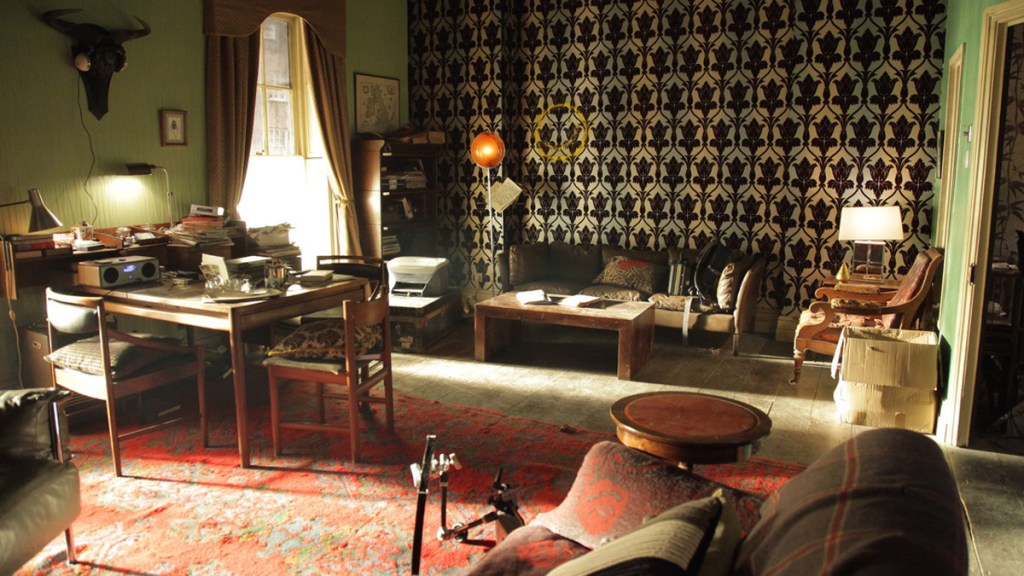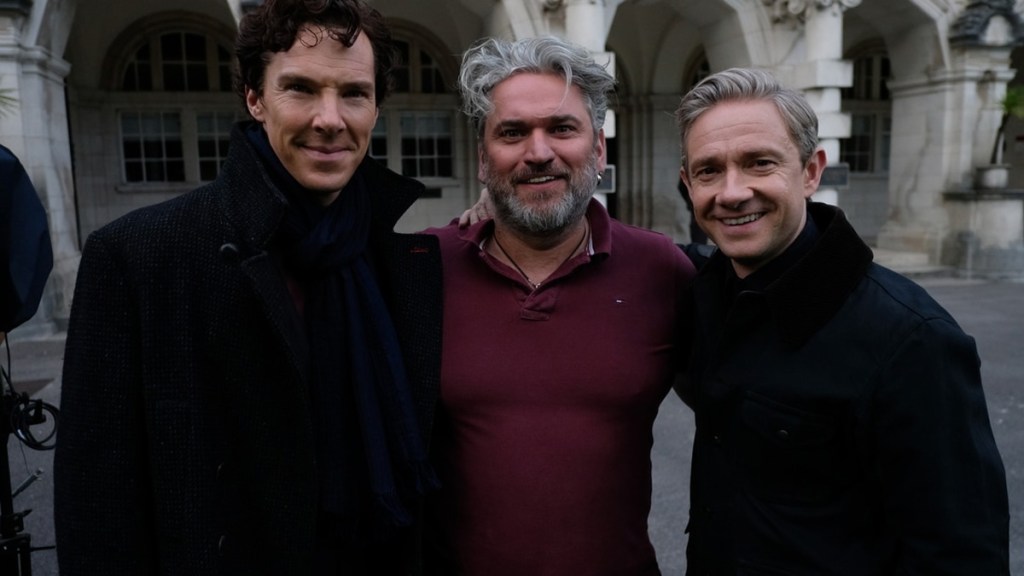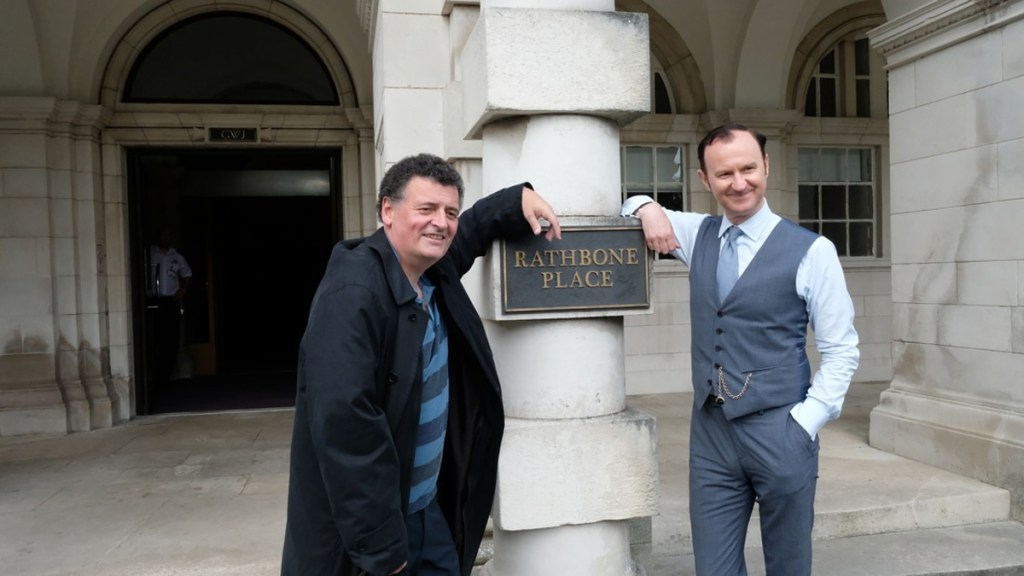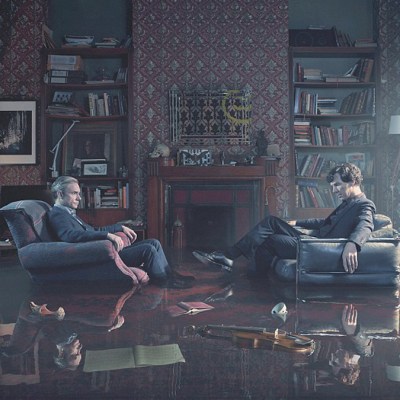Sherlock Designer Arwel W Jones: ‘There’s a Magic to Set Design’
It’s summer 2011 and Arwel W Jones is causing a commotion in the Brecon Beacons. Cars overtake his forklift along the narrow country road, puzzling at the sight of a living room wall travelling solo past hedgerows and moorland. The wall belongs to Irene Adler, sometime adversary/paramour of Sherlock Holmes. It’s on its way to stand behind Benedict Cumberbatch, Martin Freeman and Lara Pulver in the series two opener of Sherlock, to help to tell their story and to make them look good.
Storytelling and making things look good are Jones’s job. As Sherlock’s production designer, his art department conceived, created and dressed the spaces where it all happened. Take design out of the mix and the actors would have been delivering their lines in an empty studio, like the one Jones posted a picture of in early 2011. That picture took him from 200 to 5K followers in under a week. It was the moment Jones realised that Sherlock was on the brink of something big.
‘It was a surprise, shall we say! We were amazed by the series one viewing figures but I wasn’t really aware of the attention to detail people took to it until we were in prep on series two.’
I’m speaking to Jones in July 2020 at the end of a three month industry shutdown due to the global coronavirus pandemic. The Doctor Who and Dracula designer has just re-started work on one of the first UK TV projects to return to production. During the enforced hiatus, he built himself a garden room and inside are a few items fans will recognise from his TV work. ‘I have a couple of Baker Street signs, one of the little dragons from either side of the fireplace in Dracula outside the door, a sign we didn’t use for the TARDIS, a little bit of wallpaper…’

The cut of wallpaper he’s framed is the gloriously named Devil Damask Flock by Timorous Beasties. Sherlock fans will recognise it from the walls of dominatrix Irene Adler’s bedroom. It’s Sherlock’s second most famous paper, the first being the Zoffany’s Navarre fleur-de-lys used in the living room of 221B Baker Street.
A decade ago, the now-famous print was neither an obvious nor universally popular choice, Jones tells me. ‘A Study in Pink‘ director Paul McGuigan and former Doctor Who production designer Edward Thomas both walked past the decorator while it was going up and were heard to express doubt. ‘I hope he knows what he’s doing’ was the consensus opinion, the fear being that the dark pattern would look too busy on screen. ‘Then on that first day on camera it worked, and that was a sense of relief. For that to become an iconic part of the show, it’s a bit of vindication,’ he laughs. In the years since, the pattern has appeared on fan walls, been tailored into clothing and recently – a mark of our times – printed onto Covid-19 face masks.
Jones is reluctant to claim responsibility for the explosion in print wallpaper sometimes called ‘the Sherlock effect’ in real-world interior design. ‘These things go in circles. It could have just been the time for that eclectic pattern thing to come back after so many years of paint effects.’ That said, he did notice there was a lot more patterned wallpaper on television after Sherlock. If he did kick start a trend, he didn’t see any benefits, he laughs. ‘I didn’t even get a reduction on the price of the Navarre paper. We got a trade discount, but nothing more than that. It’s been discontinued now.’
The frisson created by that first empty studio photo developed into an ongoing dialogue between the designer and Sherlock fans. Throughout the show’s four series, Jones gave the fandom behind-the-scenes glimpses, teasing props and pointing out design details that may otherwise have gone unnoticed. Considering the level of devotion Sherlock inspired, the latter is unlikely. Very little was missed, says Jones. In fact, quite the opposite. Fans were so dedicated to spotting Easter Eggs and symbolism in the set designs, sometimes they saw messages where none existed.

One Tumblr blog, says Jones, had painstakingly searched through the cluster of pictures on the wall of Kitty Riley’s flat in series two finale ‘The Reichenbach Fall‘, ‘and found a link to something in the backstories of the canon of Sherlock Holmes stories for every single image.’ The truth was, the pictures had come with the location. ‘We’d papered the wall, but we put all the pictures back where they were because I quite liked what the owner of the flat had done. I really wish I had the time to get into that much depth and detail with every element of sets and dressing, but you just don’t.’
A few set design details did escape fan attention when the series first aired. Scantily clad women painted into the wall behind Adler’s staircase were only noticed by a few, says Jones, but that’s all part of the plan. ‘You do something like that for a subliminal thing. People might not have gone ‘ooh, look at that!’ but it was registering somewhere that you were in a naughty space.’
The same goes for the set of drawings in the restaurant in ‘The Empty Hearse‘ in which Sherlock first meets John Watson after faking his death at the end of series two. ‘That whole sequence had resurrection to do with it. There were the pictures of a phoenix rising from the ashes in the first restaurant, and I can’t remember what was in the café now, but the name of the kebab house was also a resurrected god.’
More personal nods to cast and crew found their way onto the sets. Since the birth of Jones’ son, his initials have popped up in some form on every show Jones has designed, in Sherlock as graffiti on the wall of a drug den in ‘His Last Vow’. In Dracula, the Tsar in the painting on the Demeter ship shared a face with his art director. In Sherlock Victorian special ‘The Abominable Bride‘, a pub sign bore the head of director Douglas Mackinnon.
Fan attention to detail was always appreciated. ‘It’s gratifying to know that the work you put in is worth it, but equally that adds a level of nervousness because you know that it will be picked apart and looked at.’

Jones’ one regret in his dialogue with Sherlock fans, he says, was a misunderstanding about hidden messages in the set design. ‘That was a little bit unfortunate. I put certain elephants in set dressing and then people started referencing #arwelephant. I’d kind of missed the link to the ‘elephant in the room’ [the term some fans had given to the homoeroticism of Sherlock and John’s relationship].’
‘I’ve always had elephants on numerous sets, to be honest with you. It was kind of an engaging thing with the fans, if I came across elephants in a prop store or something like that, I’d send a picture out and then I’d get a lot of replies, so I’d carry on, just as a little nod to them. I referenced the bullet-proof glass in Eurus’ cell as ‘Elephant Glass’, that was just a little nod to all the fans that I’d had that kind of relationship with, which I thought was quite funny.
‘I knew the link to ‘the elephant in the room’ in the script, but I hadn’t quite realised how certain people had taken it to heart. That was my one regret really, is that people thought I’d been queerbaiting, which I hadn’t at all, that would be the last thing on my mind.’
It’s the only short note of sadness in a conversation filled with laughter, pride and appreciation for Sherlock’s fans. ‘The greatest thing about the Sherlock fandom is their grace and how much reverence they have for everyone that’s worked on the show as well as the show itself.’
‘Even when we were shooting, when we had thousands of people turn up to watch the shoot and they were brilliant, they would go quiet when asked, they would move out of shot when asked, they would clean up when asked! That was always a fantastic side of it.’ The creativity of fans inspired by the show has been humbling, says Jones. ‘I’ve seen clothing, miniatures, people do their own houses, coursework for college courses, cakes! I saw a cake of John’s chair once, it’s incredibly flattering.’

The question he’s most often asked about Sherlock is when it’s coming back for series five. ‘And I have to let everyone down every time!’ Were the call to come to dust off the original sets for a return, does he have the materials to do it?
‘Technically speaking, no.’ The 221B wallpaper around the fireplace was a period piece Jones found in historical salvage. He bought the lot, ‘about 20 rolls, which I thought was more than enough. But then you don’t really expect to be still going four seasons on.’ He doesn’t have a full roll left. ‘We did dismantle that wall very very carefully to keep it, but it does still have to be cut in certain places. It depends how that comes out of storage.’
221B Baker Street is the only set currently in storage, packed away safely at production company Hartswood Films. Everything else was either recycled or binned. ‘Some of it is irretrievable, so that all goes in a skip, but anything you can gets recycled.’ Surely not everything ended up in a skip, I ask. What about the paintings of Mark Gatiss and Benedict Cumberbatch as their ancestors on display in Mycroft Holmes’ house in ‘The Final Problem’? Mark’s got the one with the bleeding eyes, says Jones.
Mark Gatiss and Steven Moffat, series creators, weren’t necessarily hard to please when it came to the Sherlock sets, remembers Jones, who also worked with Moffat on Doctor Who and the pair on BBC One’s sumptuous Dracula. ‘They’re massive, massive Sherlock Holmes fans, so you’ve got to be careful really, because they’ll be happy with most things you do for them because they love the show so much. It’s still got to do the right thing on camera, and it’s still got to tell a story.’
‘If they’re not happy with something, you’d know instantly, so it’s always a nervous moment when they walk on.’

Does he remember the first time Gatiss and Moffat walked onto the newly designed set of 221B after the unaired pilot? ‘Like it was yesterday!’
‘It was the same for that original TARDIS set, Christopher Eccleston going into David [Tennant]’s era. When you took someone onto that set – and when I was art directing that, I would quite often be the tour guide – you’d be talking about it and you’d see people stop listening to you and they’d wander off and pick things up and touch things, and that tells you a lot. When I took those two onto the 221B set for the first time, the same thing happened. They started ignoring me and were going around, sitting in the chairs, picking up props, touching things. There was definitely the same kind of vibe. They were just happy. A set that works,’ he explains, ‘that has an aesthetic to it, you get some satisfaction from being in the space. There’s a magic to it.’
Go behind the scenes on 10 Sherlock sets with Arwel W Jones.
The post Sherlock Designer Arwel W Jones: ‘There’s a Magic to Set Design’ appeared first on Den of Geek.
From https://www.denofgeek.com/tv/sherlock-designer-arwel-w-jones-theres-a-magic-to-set-design/



